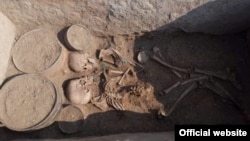How deep was their love?
Less than a meter, in literal terms, after a few meters of a burial mound was shoveled away.
But the question of the fate of a young pair buried in a face-to-face embrace more than 3,000 years ago has captured the imagination of archaeologists and the public since they emerged recently from a bountiful excavation site in central Kazakhstan.
Foreign media quickly dubbed the cradling couple Romeo and Juliet.
Couples in such twin graves are more frequently spooning, to put it in modern terms.
"From time to time the man and woman are facing each other," expedition head Igor Kukushkin was quoted as saying of the couple, who are thought to have lived around 1,330-1,250 B.C. and been 25-30 years old when they died. "This young couple is probably from an aristocratic family. It's clear this burial ground belonged to wealthy people."
But Kukushkin acknowledged that most of the pair's story remains a mystery, as does whether they died together or, for instance, the woman was sacrificed to lie alongside him after his death.
As with many fallen warriors in modern Kazakhstan during the Bronze and Iron ages, horses were buried alongside them. In some cases there are chariots, which would have been a powerful symbol of war.
She was wearing an elaborate bracelet and had other jewelry.
Regional authorities in Qaraghandy, one of a several archaeological hot spots in central Kazakhstan, recently shared the discoveries from excavations in Shet, including photos of the would-be lovers in their shallow grave.
They include images of the findings at a site that includes many ancient nomadic burial mounds, known as barrows or kurgans, and stone fortifications.
Many of Kazakhstan's richest archaeological sites originate from the so-called "sak" period on the steppes, roughly corresponding to the early Iron Age.
Although Romeo and Juliet works for Westerners, locals might be more inclined to think of them as Kozy Korpesh And Bayan-Sulu, an ancient Kazakh lyrical poem about doomed lovers that was repeated for centuries before being recorded and archived by Romantic-era Russian poet and novelist Aleksandr Pushkin.
Their story has been immortalized over and over again in Kazakh recordings, film and, of course, on YouTube.
Kazakhstan even marks a National Day of Lovers on April 15 that is widely seen as being given over to Kozy Korpesh and Bayan-Sulu.
But Kazakhs nevertheless appear to be getting a kick out of the Western interest that the discovery of the steppe Romeo and Juliet is causing.
TengriNews.kz cited a "surge in interest in Kazakh history" after the finding and the interest it sparked abroad.
Kazakhstan is among the most ethnically diverse of the former Soviet republics, but many of its 18 million people identify proudly with the region's traditional, nomadic lifestyle.
Scientists recently identified a terraced stone mausoleum at another Kazakh dig that sparked talk it could predate the Egyptian pyramids and shift the dawn of quarried architecture back by around 1,000 years.
But those reports turned out to have been wildly overstated.
Archaeologists also unearthed the bodies of 12 fully saddled and outfitted horses in a burial mound for a nomadic pair in Bukhtarma Valley, in eastern Kazakhstan's Altai highlands, in 1999.










